Have you noticed wasps that are chewing your wooden outdoor furniture or your wooden deck? You are probably wondering if wasps eat wood.
Continue reading to find out about the most common wasps that will eat your wood and what they use it for.
Table of Contents
Can Wasps Eat Wood?
What do wasps eat in the wild?
Adults wasps, both the social and solitary wasp, feed on sugars. In the wild, they sip on flower nectar and honey. They love fruit, which is why they are considered pests on farms. Many will also feed on small insects they come in contact with.
The larvae of wasps feed on caterpillars, true bugs, spiders, and plants.
Can they eat wood?
Yes, they can, but they don’t actually eat the wood. What they do is chew the wood, which when mixed with their saliva, helps them create a palp, which they use to make their nests.
Any wooden structures or furniture in your home should be wasp protected, reducing the risk of the wasps chewing on your wood and causing damage.
Why do they eat wood?
Thousands of wasp species throughout the world can chew wood, which is known as girdling. Sometimes you can hear the wasp as they scrape the wood away. Girdling helps the wasp create cellulose to build her nest.
In the United States, paper wasps, yellow jackets, and hornets are known to chew on wood.
18 Wasps That Eat Wood
18 wasps that will chew on wood in the United States, include:
1. Dark Paper Wasp
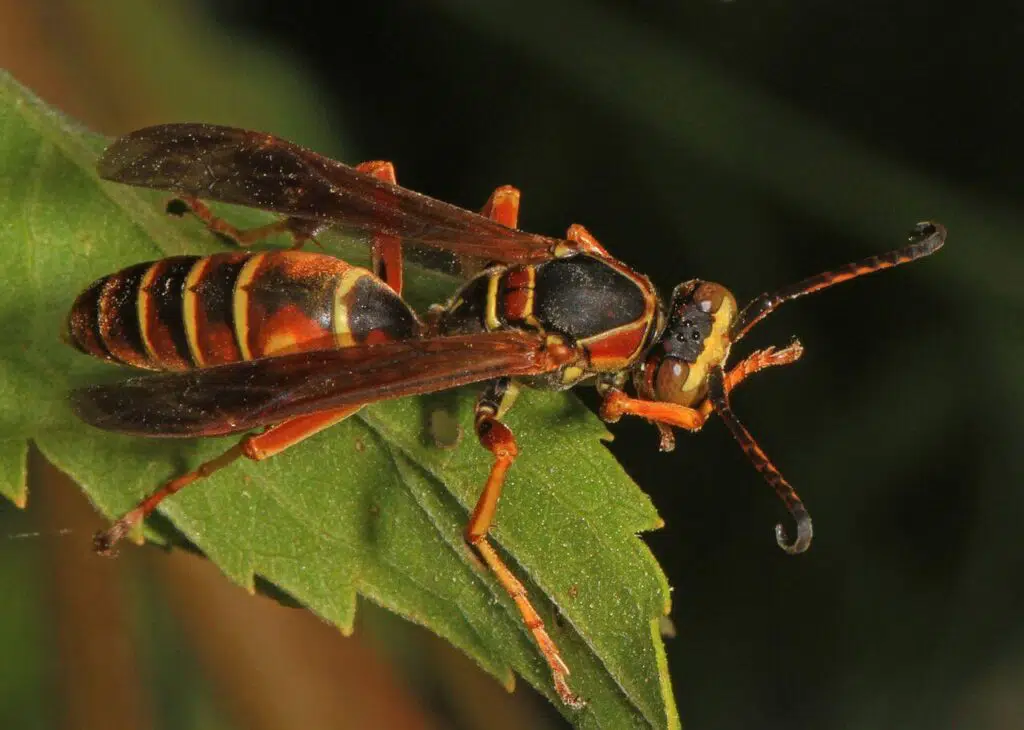
The dark paper wasp (Polistes fuscatus) creates their nests in savannas and woodlands and is common near human homes. They create nests where there is no shortage of exposed wood, which they use to create their nest.
These wasps grow to around 21mm in body length and are slender with an obvious waist connecting their abdomen and thorax. They are dark red/brown with the body being segmented by yellow banding. The females are the ones with the sting.
These wasps build nests out of paper, which is made from chewed-up wood and vegetation.
2. Common Aerial Yellowjacket
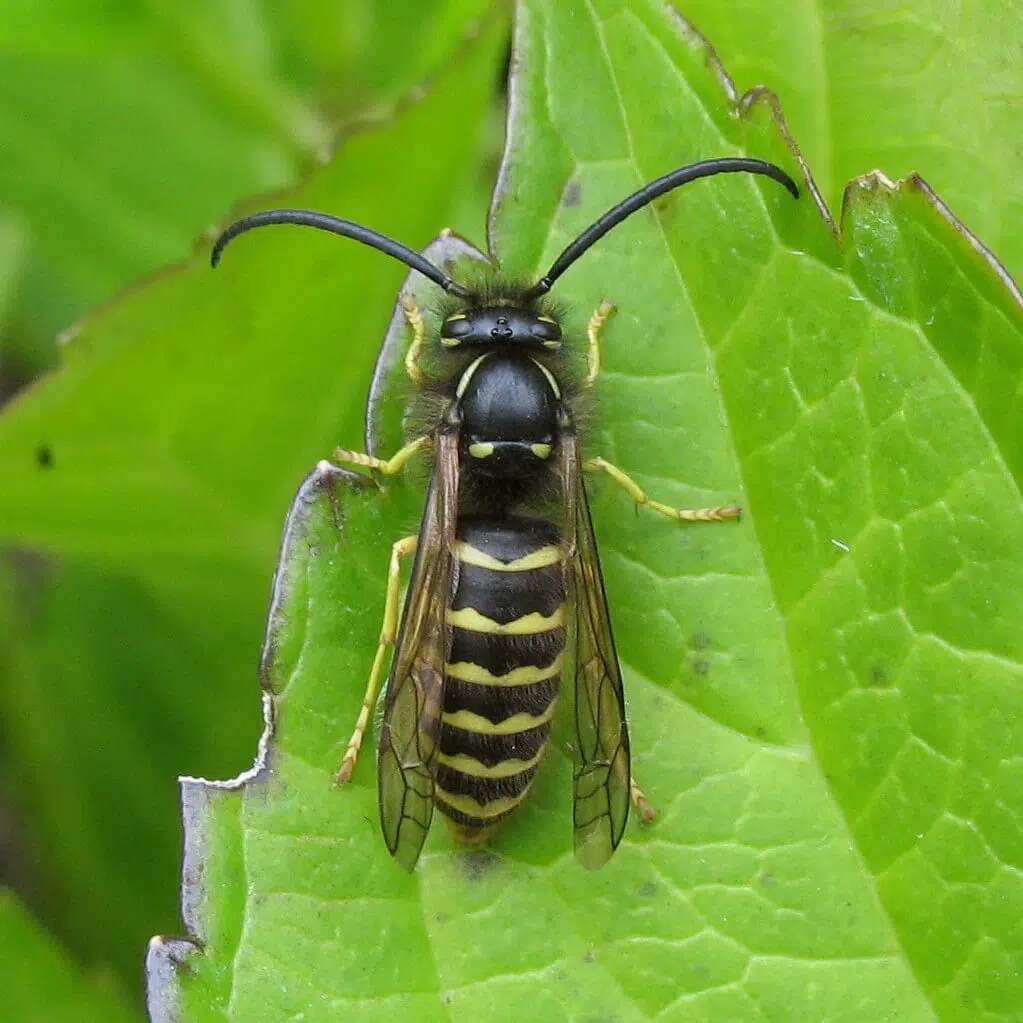
The common aerial yellowjacket (Dolichovespula arenaria) can be found from central Alaska to New Mexico and Arizona in arboreal and subterranean habitats. They start building nests from March in California and May for the rest of the country.
Their diet comprises spiders, lacewings, lady beetles, crickets, and grasshoppers. Their nests are usually at least a few centimeters from the ground, sometimes on the top of trees or homes. They are also known to build nests underground, though they prefer higher up.
They build their nests from paper, which is chewed wood and plant fibers mixed with their saliva.
3. European Paper Wasp
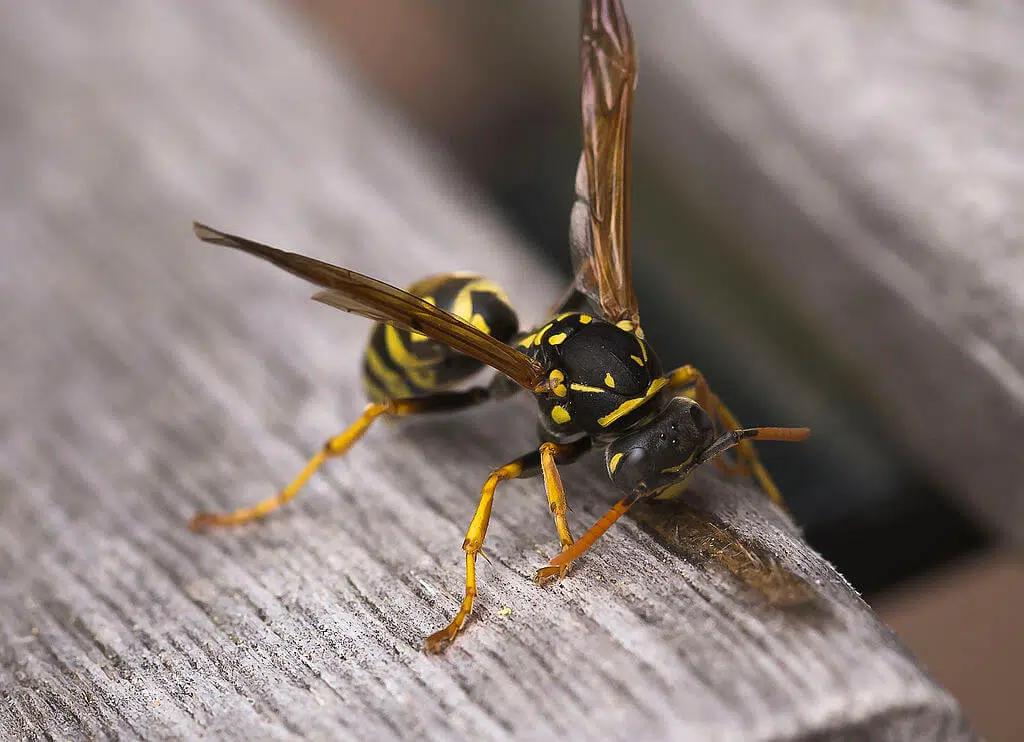
European paper wasps (Polistes dominula) are more common on the east coast of the United States, but they have spread to the Midwest and the western and southwestern United States.
These wasps prefer forest and grassland areas, though they do live in urban and suburban areas, along with agricultural locations.
They tend to nest in man-made structures. These are black wasps with yellow markings and rings. Those with more black and only one spot on the clypeus suggest dominance and size. Their antennae are red/orange.
They are not as big as the Northern paper wasp, growing to 2cm in body length. They fly with their back legs held below the body. Females are slightly larger than males. They chew on wood, which is mixed with their saliva to create paper-like nests.
4. European Hornet
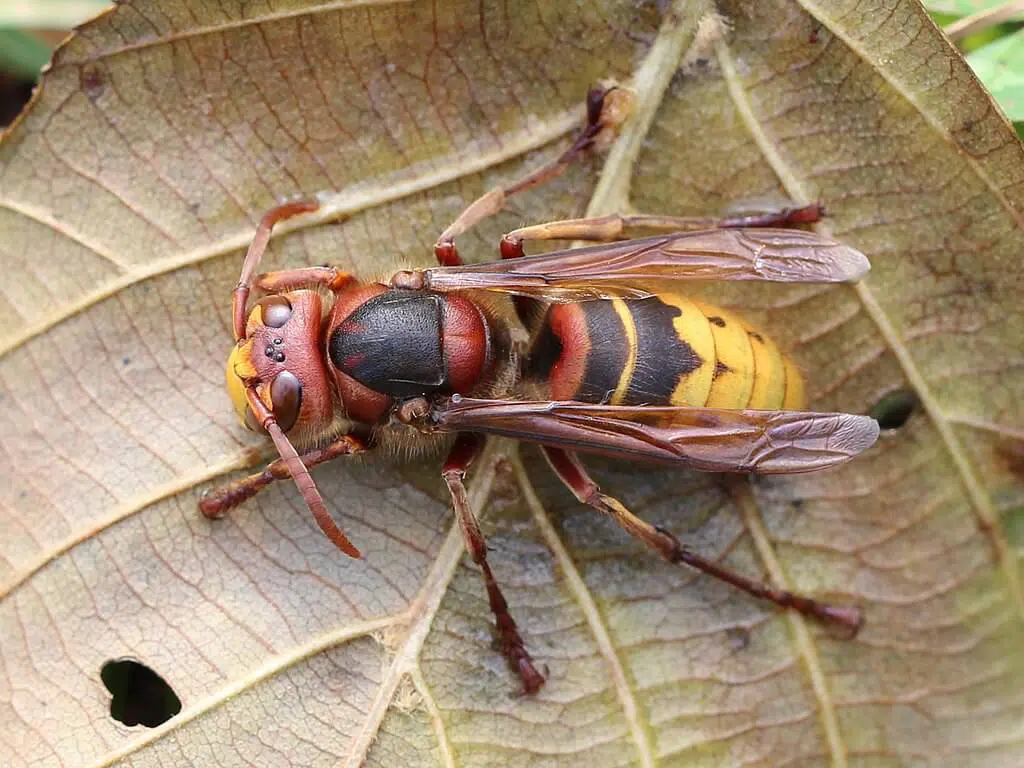
European hornets (Vespa crabro) are large wasps native to Europe, which were introduced to North America in the 1800s. They’re not aggressive but will sting if stepped on.
They are mostly carnivorous and eat insects, including other wasps, beetles, moths, and dragonflies. They also feed on fallen fruit.
They have orange/red wings, a striped brown and yellow abdomen, and hair on the abdomen and thorax. Workers grow to around 25mm in body length with queens growing to 35mm in body length. Females have six abdominal segments, while males have seven.
They make paper-like nests from plant materials and wood.
They live in paper nests, which have a paper comb on the inside and a single entry hole. They use branches, twigs, plant resources, and any exposed wood to chew and shape into a nest. They are glued together closely but are not uniform.
5. Guinea Paper Wasp
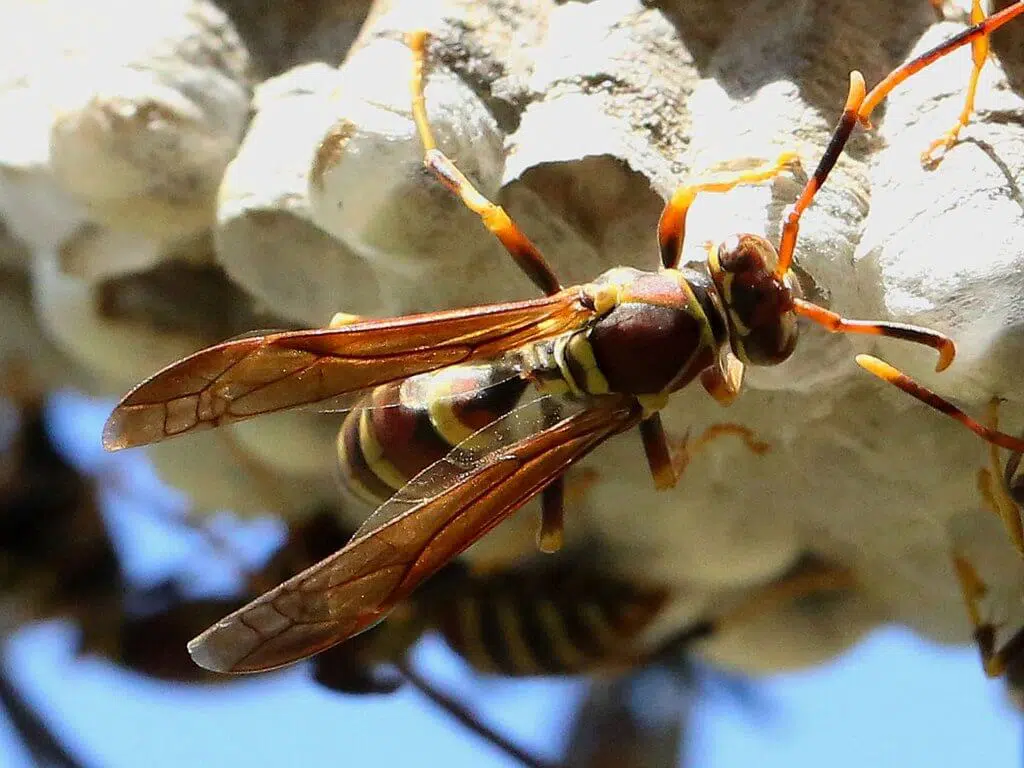
Guinea paper wasps (Polistes exclamans) are common in Alabama, Arkansas, Arizona, North and South Carolina, Georgia, Florida, Louisiana, Oklahoma, and Texas. They always have some yellow coloration, even though they may vary from one state to the next.
There are usually four yellow stripes on the propodeum and yellow lines on the mesonotum. There may be yellow on the head with purple coloration on the wings.
6. Parasitic Aerial Yellowjacket
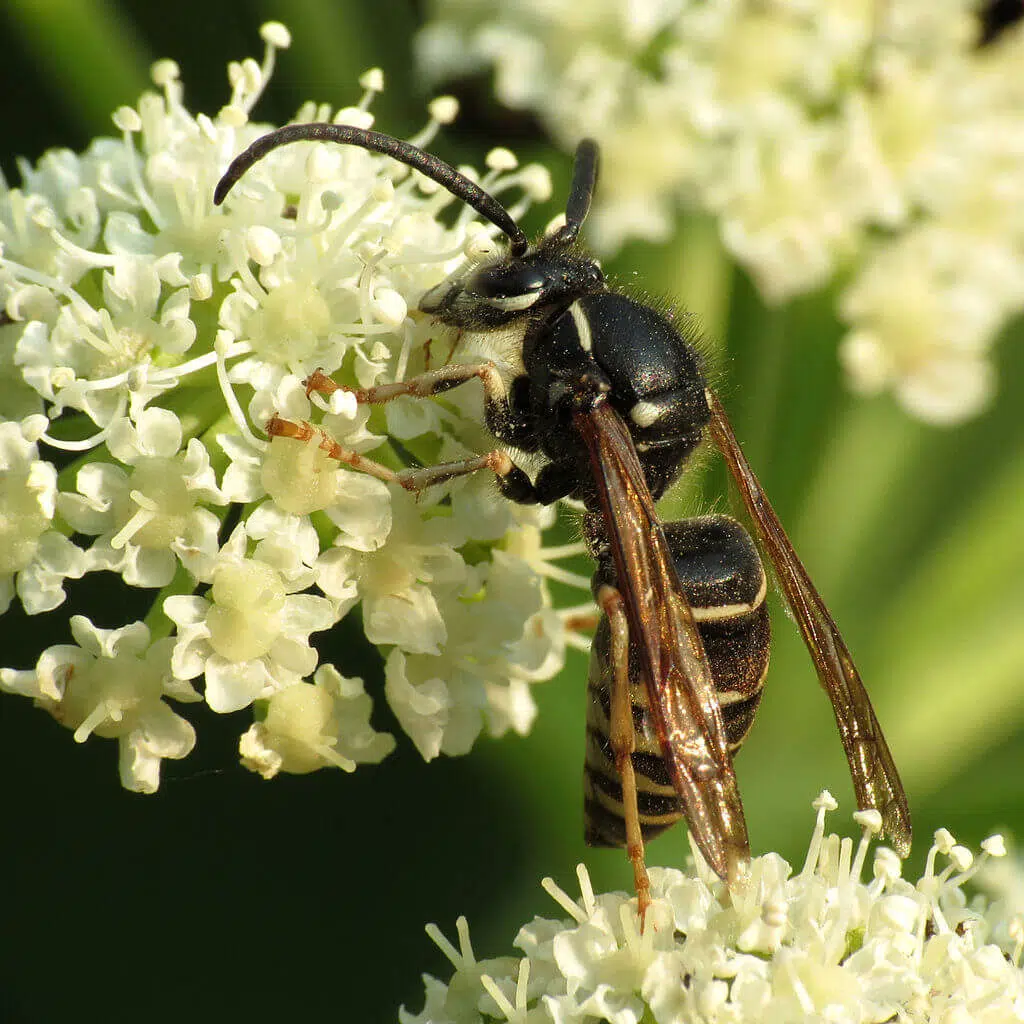
The parasitic aerial yellowjacket (Dolichovespula arctica) can grow to 15mm in males and 18mm in queens. Larvae are reared by host workers. Their paper nests, which they make from chewed wood and vegetation, can be found in subterranean and arboreal habitats.
They are known for building nests on buildings, where the queen initiates the colony in spring.
7. Metric Paper Wasp
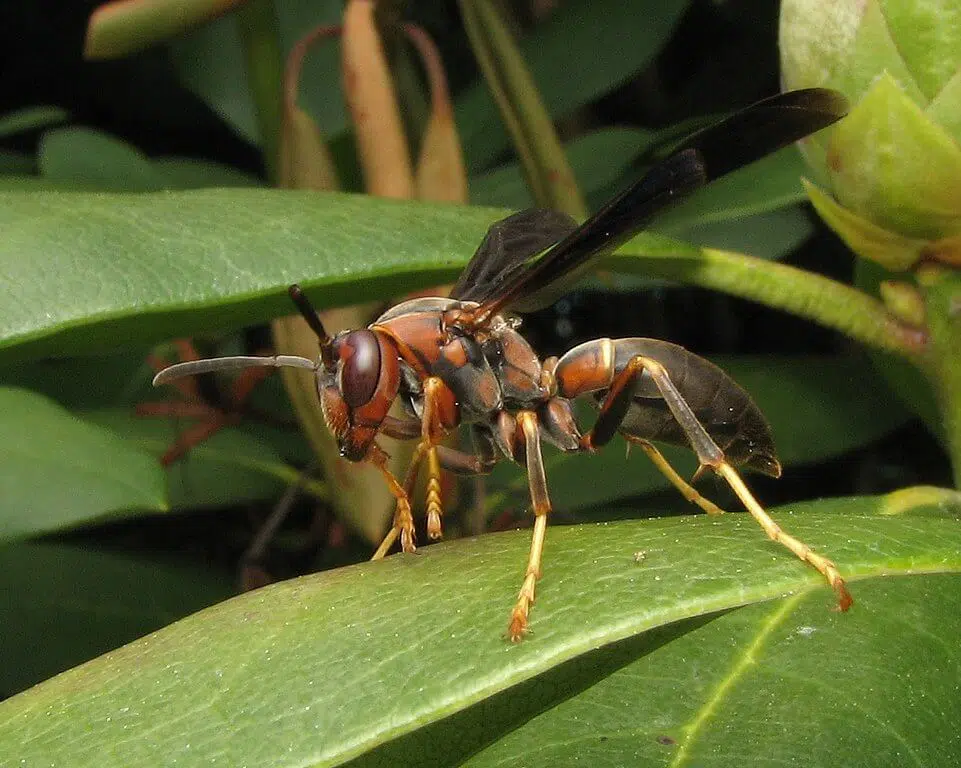
This rusty-colored wasp has black markings on the thorax with a black abdomen. Their legs are black with yellow and a black spot that separates from the antennae. Females have six abdominal segments, while males have seven.
These wasps are common in North America from Maine to Oklahoma, Texas, and New York. They choose nesting sites based on the elements, lighting, water source, and size. Their nests are often found in barns and sheds, sometimes under eaves.
In the summer you can see them making regular trips to the water for hydration.
8. Eastern Yellowjacket
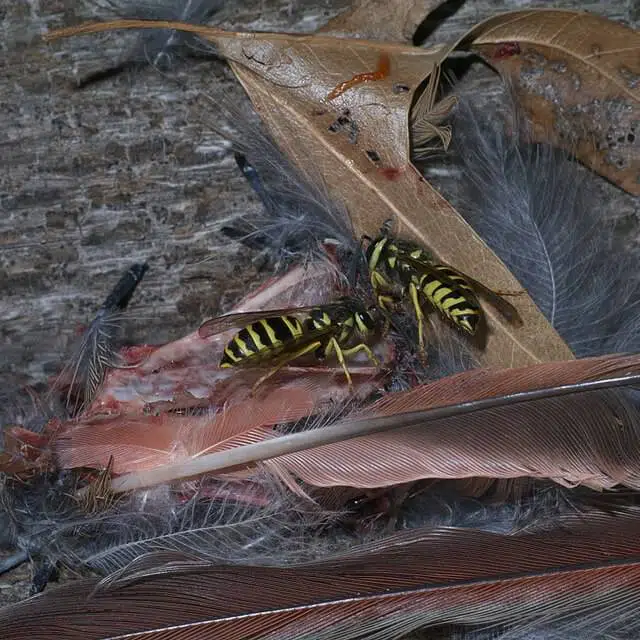
These are small wasps with black and yellow lines on the abdomen, thorax, and head. They have a curved body, which can grow to 15.9mm in length. They build nests up to 300mm in diameter, comprising 15,000 cells or more.
The envelope of the nest is red/orange to tan/brown. It is made from decayed wood, which is chewed and mixed with saliva to create a quick-drying pulp. These wasps are common throughout eastern North America. Their nests are created in sheltered areas, such as tree stumps and attics.
9. Western Yellowjacket
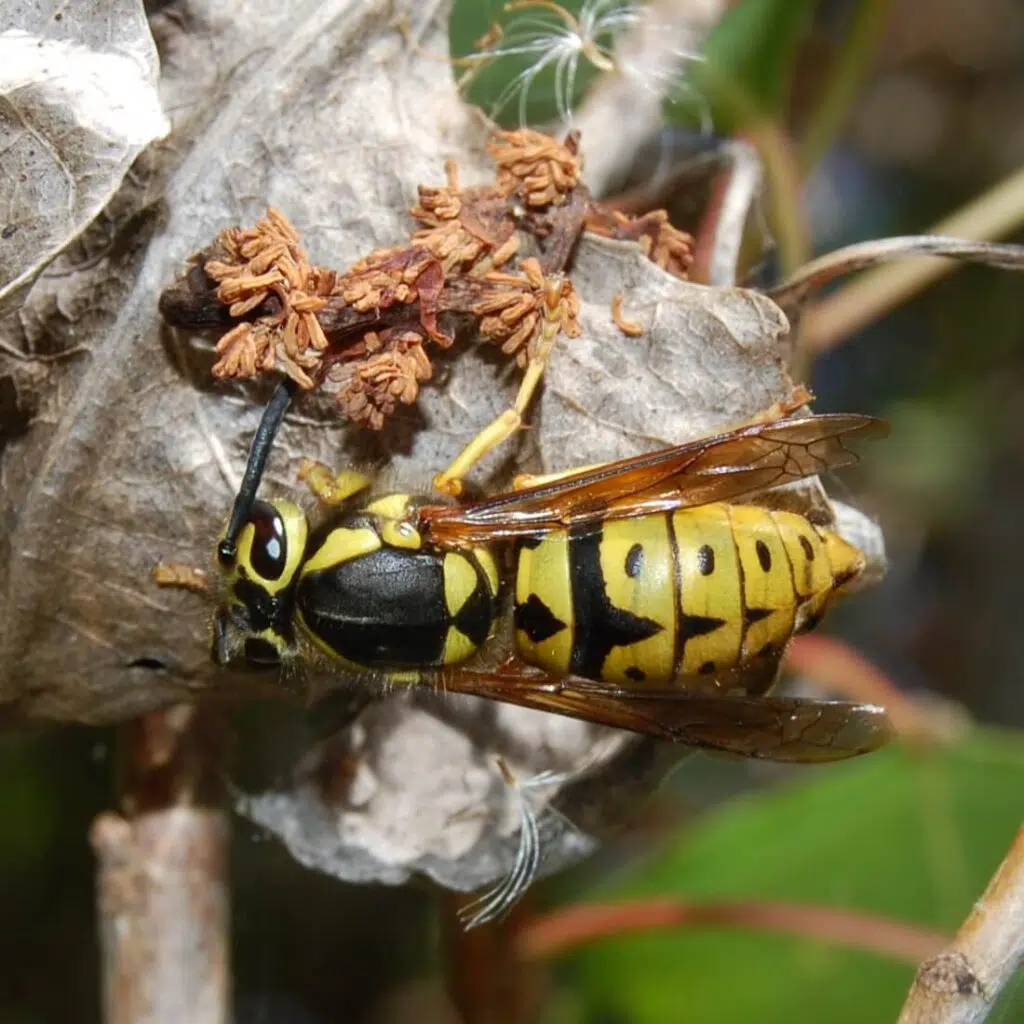
Western yellowjackets (Vespula pensylvanica) are native to North America, especially in those with temperate climates. They are greatly reduced in colder months, but their populations explode in the warmer months, which has made this an invasive species in Hawaii.
These are black and yellow wasps, which build large nests from chewed wood, which is enclosed in an envelope with a small single tunnel entrance. Nests are usually below the ground or in crevices. They are common in forests, prairies, gardens, meadows, parkland’s and houses.
10. Southern Yellowjacket
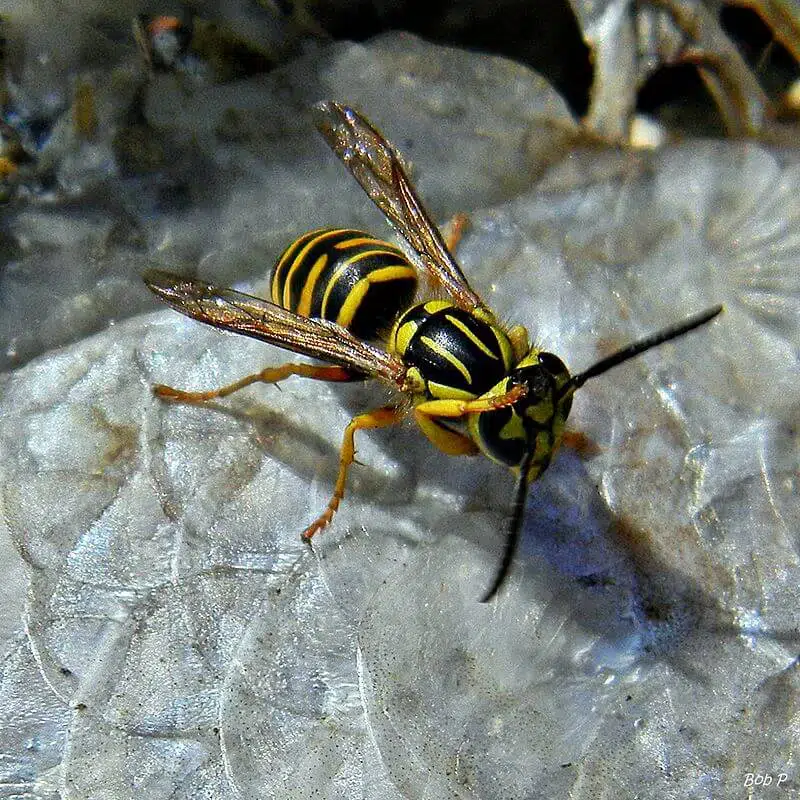
The southern yellowjacket (Vespula squamosa) is a social wasp that is black and yellow with an orange queen. They are common in eastern North America and Central America. They create large multiple comb nests.
They feed mostly on insects and animal carcasses. They are known for their painful and venomous sting, with many considering this wasp as a pest. They grow to around 1.3cm in length with a black body and yellow stripes, which cover the entire body.
They are hairless with clear wings. Queens are larger and are orange in color. They live in areas with warm weather and sometimes tropical climates. They are common in years, on the side of roads and in parks.
They tend to build their nests in unnatural areas, such as on picnic tables and under porches. They make their nests from chewed wood and vegetable fibers with colonies containing up to 450,000 cells.
11. Hunter’s Little Paper Wasp
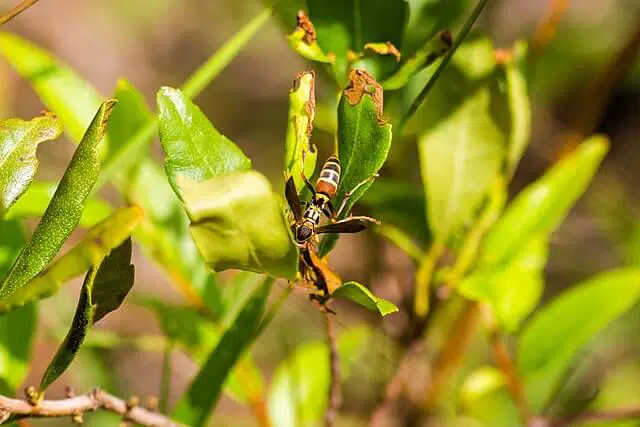
The hunter’s little paper wasp (Polistes dorsalis) is small. They are rusty in color with yellow banding and dark brown wings. They create honeycomb paper nests, which can be up to four inches.
These wasps rely on wood, vegetation, twigs, and other organic matter to create their nests, which are chewed and mixed with their saliva.
12. Golden Paper Wasp
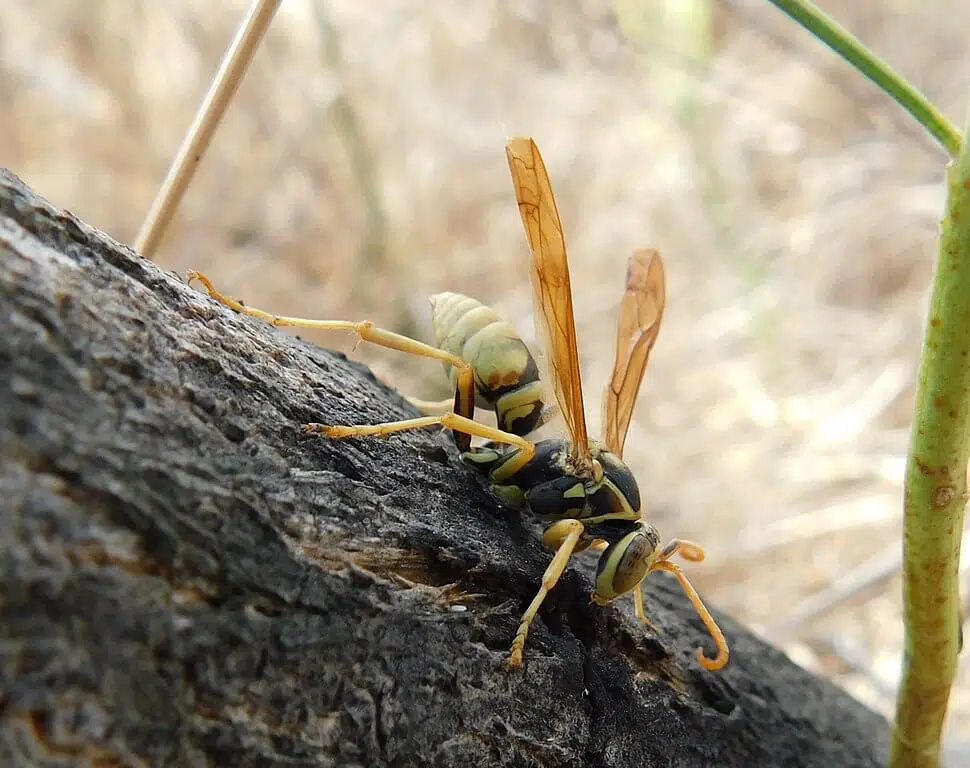
The golden paper wasp (Polistes aurifer) belongs to the Vespidae family and can be found from the western part of North America to northern Mexico and southern Canada. They are mostly black with some yellow markings and restricted rusty red coloration.
These are paper wasps, which can chew wood and other vegetation. They mix the chewed matter with saliva to create a quick-drying past, which they use to create their nests.
13. German Yellowjacket
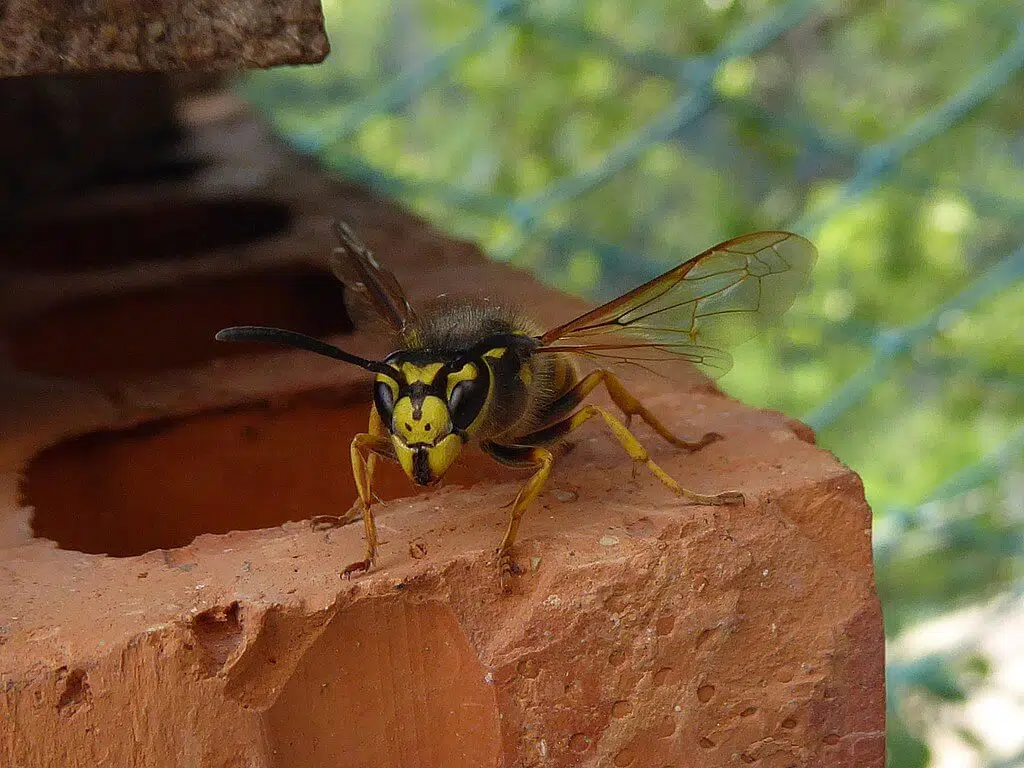
This wasp (Vespula germanica) can be found throughout the Northern Hemisphere and is native to Europe and Northern Africa. It has become well established in North America and is often mistaken for a paper wasp. They build gray paper nests, also chewing on wood and other matter to create a paste.
These wasps grow to around 13mm in body length and are typically black and yellow. They feed on native arthropods, making them an invasive species, which causes harm to indigenous wildlife.
Their nests are often found below the ground, though they do build nests in attics and other artificial structures.
14. Ringed Paper Wasp
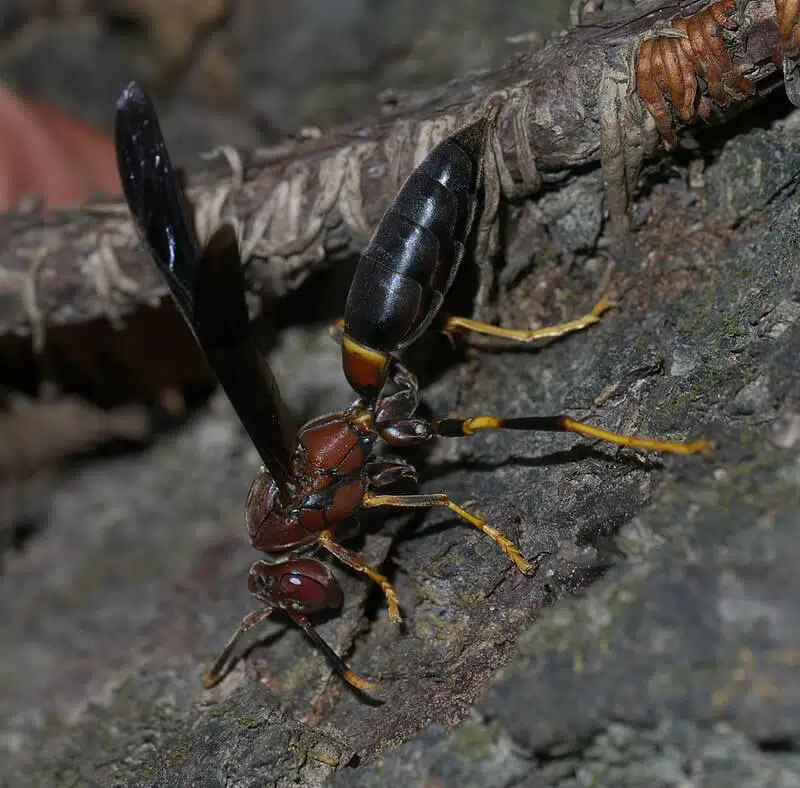
Ringed paper wasps (Polistes annularis) have narrow first metasomal segments with orange antennae segments. They are common in the eastern United States with a rusty red head and thorax and black abdomen. There is a yellow sign at the end of the first segment.
They can be differentiated from the members of P.Bahamensis in Florida, Louisiana, and North Carolina by the lack of yellow on the mesopleuron and mesonoma, along with no yellow banding on the tergum.
The ringed paper wasp can be found throughout the eastern United States from Florida to New York and South Dakota to Texas. They create nests on branches and shrubs and in buildings. They group their nests in colonies on the underside of overhangs that are blocked from sunlight exposure.
15. Fine-backed Red Paper Wasp
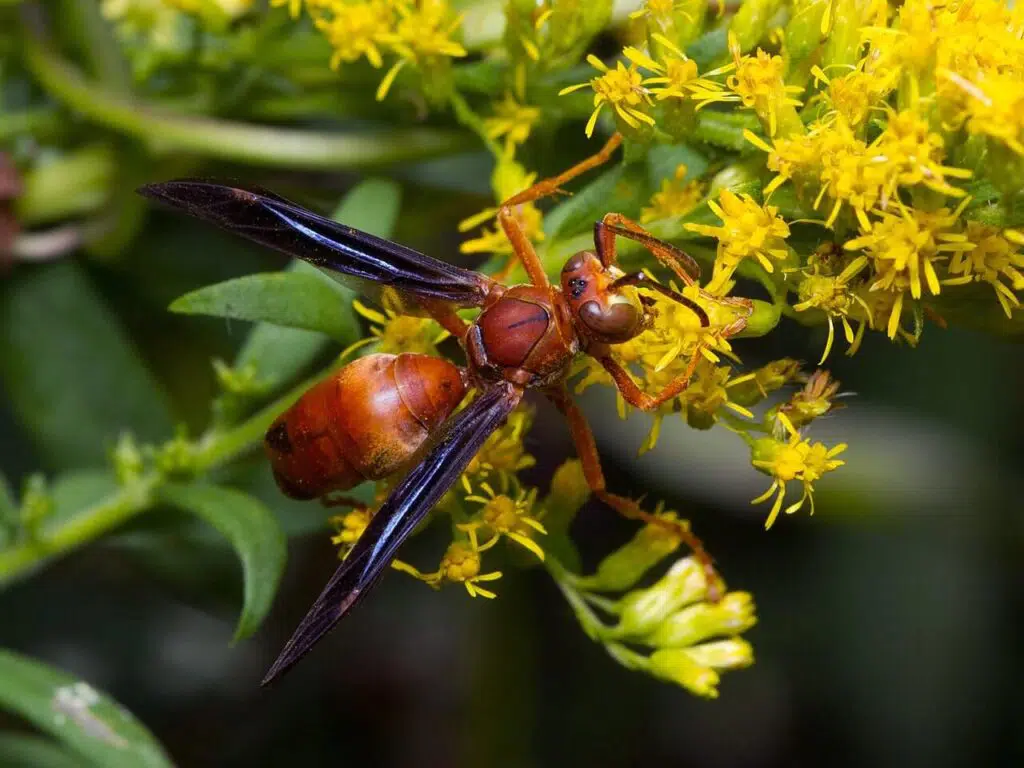
The fine-backed red paper wasp (Polistes Carolina) belongs to the Vespidae family and is commonly found in the eastern United States. They are red/brown in color. They are known for constructing large nests in protected places, which are made from chewed organic matter, including wood.
16. Bald-faced Hornet
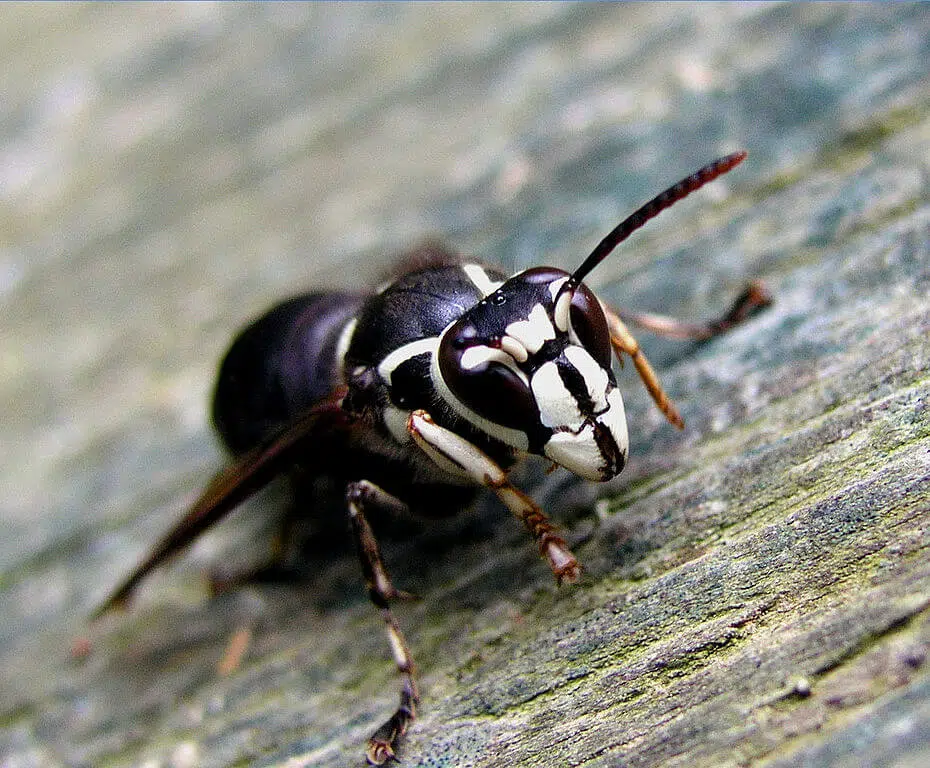
Bald-faced hornets (Dolichovespula maculata) are black and white with a white or baldfaced head. They have three white stripes at the end of the body and grow to 19mm in length. Queens are larger than the workers.
They create egg-shaped nests that can be up to fourteen inches in diameter and 23 inches in length. They are layered hexagonal combs, covered in an envelope. The nest is made from a wood fiber mixed with saliva, which creates a pulp.
They are common in North America and Canada, though they are more common in the southeastern United States. They prefer forested areas and urban areas with nests in bushes and trees, sometimes on the side of buildings.
These omnivorous wasps feed on flies, spiders, and caterpillars. They are very aggressive in nature and will defend their nest, stinging humans who come too close.
17. Apache Paper Wasp
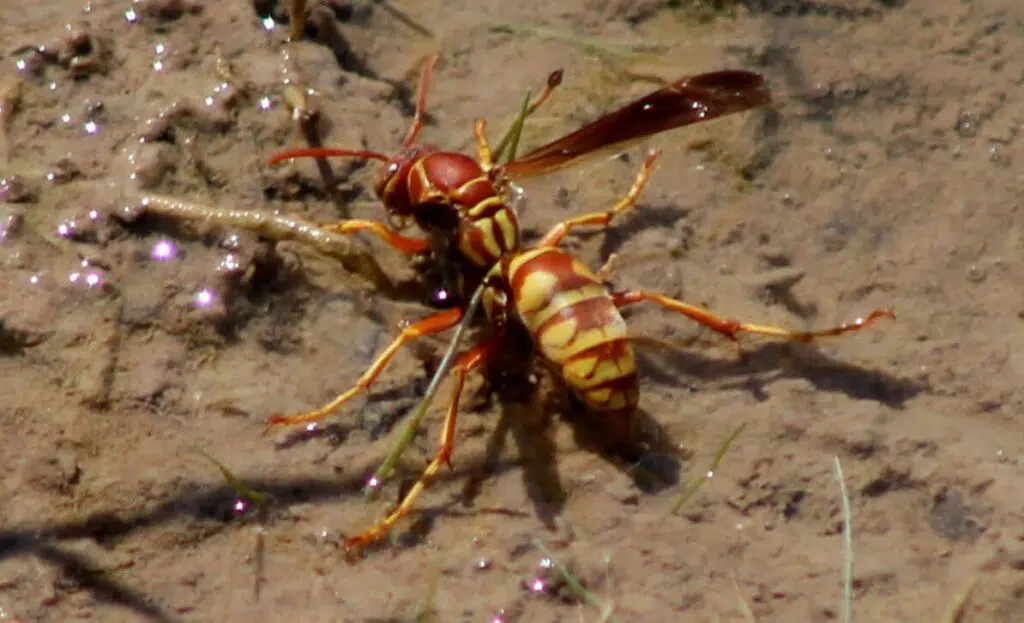
Apache paper wasps (Polistes apachus) are native to western North America, also referred to as the Texas paper wasp. They are considered a pest, due to their aggressive nature and painful stings. They can be found in agricultural land, orchards, and vineyards.
They are also known to create nests in houses in urban areas in California. They create a paper-like material from wood and other organic material, which is mixed with their saliva to create their nests.
18. Coarse-backed Red Paper Wasp
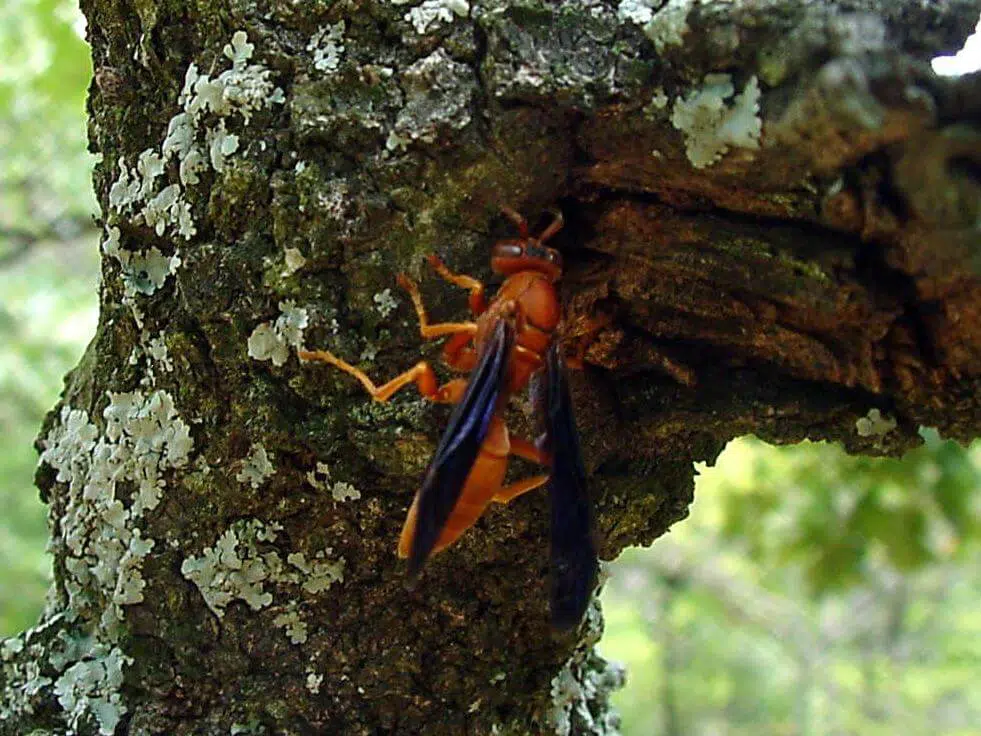
Coarse-backed red paper wasps (Polistes rubiginosus) are rusty red with black to brown markings. Their fore wings can grow to 21.5mm in males and 18mm in females. They are the only red-colored wasp species in the eastern United States, along with Polistes Carolina.
They are endemic to the United States from Maryland to Georgia and Illinois to Texas.
Bonus 1: Wood Wasps
Wood wasps or horntails are more than one hundred and fifty non-social species of Siricidae, a wood-eating sawfly. They are not wasps but sawflies, which have spine-like structures at the end of the abdomen.
The spine-like structure is used to pierce bark or wood, inserting eggs into the wood. These flies are usually blue, brown, or black with yellow or red and can grow to 4cm in length.
They are known to infest needle-leaved trees and broad-leaved trees. The female lays her eggs in the tree and the larvae live in the tree for two years. The wood-rotting fungi found in the horntail tunnels result in deterioration of the wood, reducing the risk of salvaging it.
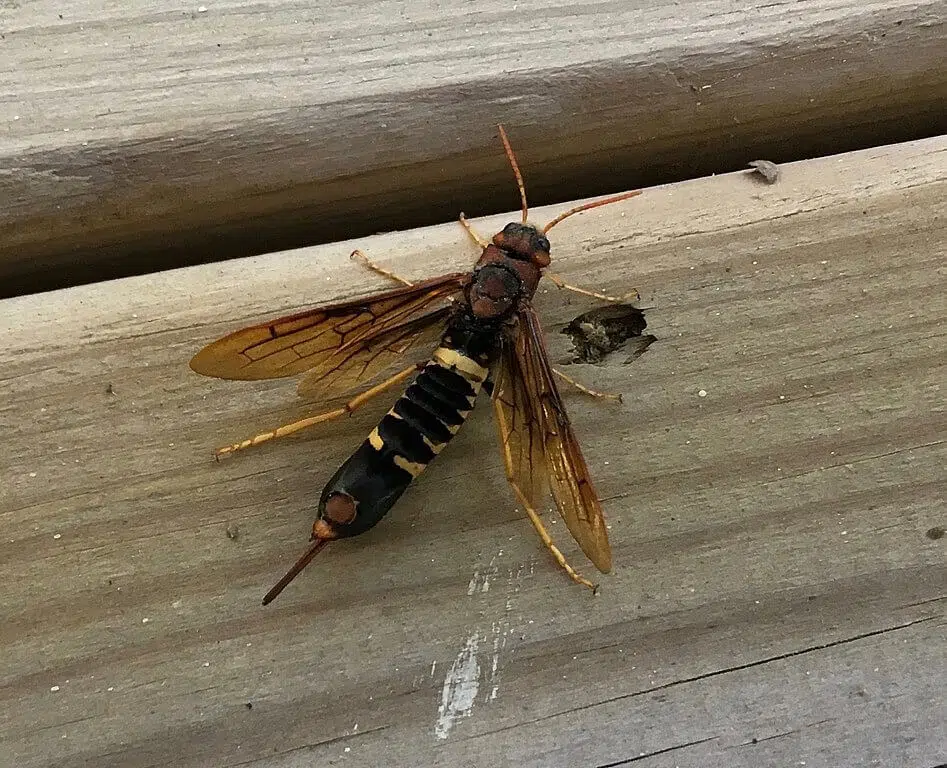
Some common species in the USA include:
- Pigeon Horntail (Tremex columba)
- California Horntail (Urocerus californicus)
- White-horned Horntail (Urocerus albicornis)
Bonus 2: Ichneumon Wasps
Ichneumon wasps lay parasitoid grubs in Sirex, which means they inject their eggs into the wood. The fungus is contained, nourishing it with secretions. This changes to digested wood for larvae. They are considered invasive species that are spread throughout the world.
There are more than 25 thousand species of this wasp described. They attack immature stages of insects and spiders that have four life cycle stages; egg, larva, pupa, and adult.
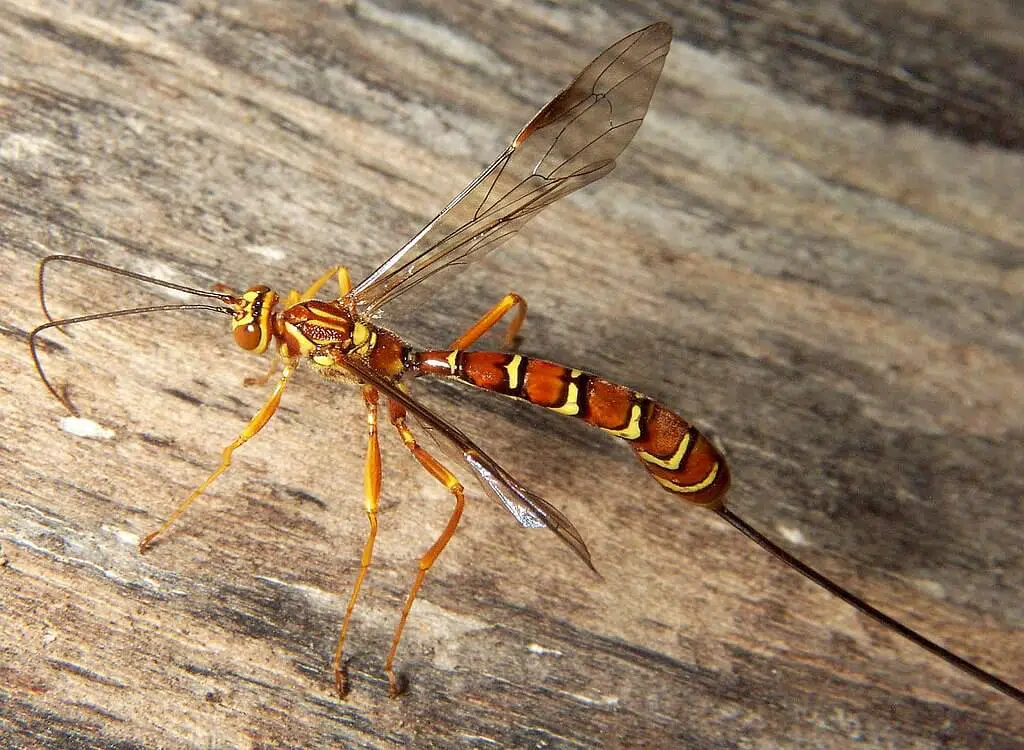
Some common species in the USA include:
- Long-tailed Giant Ichneumonid Wasp (Megarhyssa macrurus)
- Black Giant Ichneumonid Wasp (Megarhyssa atrata)
- Greene’s Giant Ichneumonid Wasp (Megarhyssa greenei)
Summary
Social wasps, such as paper wasps, chew on wood in order to create their nests. Then there are horntails or sawflies, which insert their eggs into the wood, as do the ichneumon wasps.
Knowing the wood chewing wasps can help you identify them quickly. You can take natural measures, such as planting spearmint, thyme, eucalyptus, and citronella where you find the wasps. They don’t like these plants and it should help to keep them away.
Further Reading: